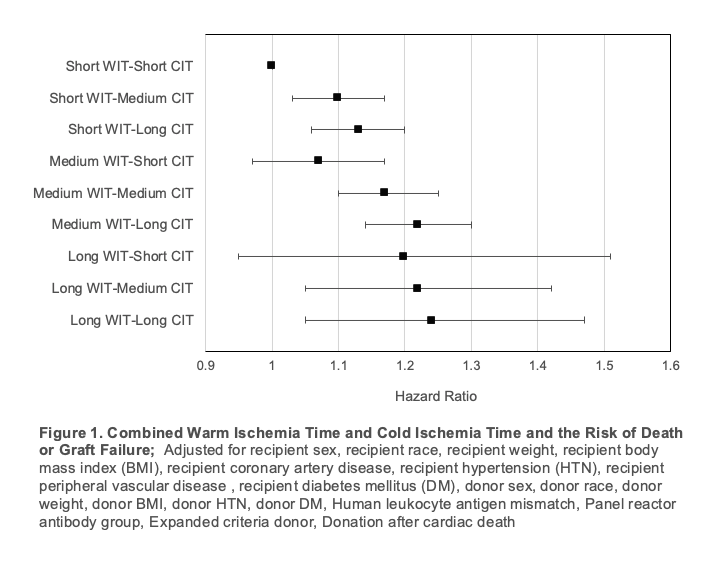The Impact of Combined Warm and Cold Ischemia Times on Post Transplant Outcomes
1Faculty of Medicine, Dalhousie University, Halifax, NS, Canada, 2Division of Nephrology, Medicine, Dalhousie University/ Nova Scotia Health, Halifax, NS, Canada
Meeting: 2021 American Transplant Congress
Abstract number: 422
Keywords: Graft failure, Ischemia, Survival, Warm ischemia
Topic: Clinical Science » Kidney » Kidney Technical
Session Information
Session Name: Kidney Deceased Donor Allocation 2
Session Type: Poster Video Chat
Date: Sunday, June 6, 2021
Session Time: 7:30pm-8:30pm
 Presentation Time: 7:30pm-7:40pm
Presentation Time: 7:30pm-7:40pm
Location: Virtual
*Purpose: Both prolonged warm ischemia time (WIT) and cold ischemia time (CIT) have been associated with an increased risk of graft failure following kidney transplantation, however their combined impact has yet to be studied. In this analysis of United States kidney transplant recipients, we explored the additive effect of prolonged WIT and CIT on the risk of death or graft failure following kidney transplantation.
*Methods: The Scientific Registry of Transplant Recipients was used to identify renal transplant patients who underwent deceased donor kidney transplantation between 2005 and 2014. We included only those with complete data for WIT and CIT and excluded extremes of both exposures (WIT<10 minutes or >120 minutes, CIT<1 hour or >24 hours). The outcomes of death/graft failure were captured until September 1, 2017. WIT and CIT were separately categorized using linear splines to determine cut points. WIT and CIT were classified as short, medium and long (0-40 min, 40-80 min, >80 min respectively for WIT; 1-8.7 hrs, 8.7-16.3 hrs, >16.3 hrs respectively for CIT). A combined WIT-CIT variable included all WIT-CIT combinations, with the reference group being short WIT-short CIT (0-40 min WIT, 1-8.7 hrs CIT). Multivariable cox proportional hazard models were used to determine the association of combined WIT-CIT on the composite outcome of death or graft failure.
*Results: A total of 54, 745 deceased donor kidney transplant recipients had complete data for WIT and CIT. Median WIT and CIT were 35 (IQR 18) minutes and 14.5 (IQR 8.8) hours, respectively. There was an incremental increase in the risk of death/graft loss for categories of CIT and WIT. Adjusted hazard ratios for death or graft failure increased across combined WIT-CIT groupings relative to reference patients, with the highest risk of an event being in the setting of combined long WIT-long CIT (HR 1.24, 95% CI 1.05-1.47), Figure 1.
*Conclusions: Prolonged WIT-CIT was associated with an increased risk of the composite outcome of death or graft failure in a small but graded manner. Attempts should be made to minimize both CIT and WIT in order to optimize post-transplant outcomes.
To cite this abstract in AMA style:
Foley ME, Vinson AJ, Tennankore KK. The Impact of Combined Warm and Cold Ischemia Times on Post Transplant Outcomes [abstract]. Am J Transplant. 2021; 21 (suppl 3). https://atcmeetingabstracts.com/abstract/the-impact-of-combined-warm-and-cold-ischemia-times-on-post-transplant-outcomes/. Accessed December 28, 2025.« Back to 2021 American Transplant Congress

